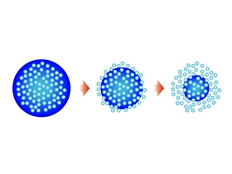You are here: Home » Insight hub » Case Studies » Encapsulation of Bleach
Encapsulation of Bleach
Introduction
Lucideon collaborated with an industry partner to produce a slow release, glass based system. The desired outcome of this partnership was to develop a system capable of delivering a bleach, at the required time, in an automatic dishwasher (ADW) cycle. Bleach encapsulation is important to prevent the denaturing of enzymes, both of which play an important role in dishwasher detergents.
The trial was intended to demonstrate improved stability behavior using a preformed bleach granulate material, coated with glasses of differing solubility. The release of the bleach and storage stability of the coated granulate was to be shown by combining granulate with ADW gel material over a period of up 2 weeks at two temperatures.
The Challenge
Lucideon needed to successfully encapsulate the bleach within the slow release system and then develop test methods to determine whether; the silicate coating formed an effective barrier between the bleach and other ADW gel components, the coating material reacted with the bleach and the glass coating produced a continuous film.
What We Delivered
Lucideon experts assessed the durability of the coating when in contact with an ADW gel by coating glazed ceramic tiles with the glass and exposing the coating to the automatic dishwasher gel, for up to two weeks, at room temperature and at 40°C. The coatings were assessed visually and using Scanning Electron Microscopy/Energy-Dispersive X-ray Spectroscopy (SEM/EDX).
Assessment of the reactivity of the bleach with water and glasses was performed. Bleach granulate was combined with glass and the potency was indicated by reaction with KI solutions. Subsequent analysis of the reaction products was performed using Fourier Transform Infrared Spectroscopy (FTIR).
We also tested the thickness of the coating and its composition to confirm the presence of a continuous film. Its thickness and composition coating thicknesses were physically measured and analysed using SEM/EDX.
Value to the Client
Due to the conclusions that glasses could form hard coats and that partial survival of bleach in coated granules was possible with the particular compositions tested, it was concluded that a related system could be used to:
- coat and preserve other suitable materials which are compatible with the glasses
- provide protection to the bleach when coated in a granular form, with an acceptable partial loss of efficacy during the coating process. The coated material may then be incorporated in dry tablet/powder products to prevent contact and reaction with enzymes etc.
Further investigations are now being conducted to improve the compatibility with bleach and ADW through optimization of the glass chemistries, encapsulation pH, and drying process.
